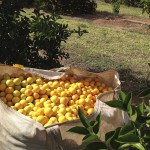Orange Oil CP Citrus sinensis Harvest: July - December
The 2016/17 season is finally over and for many it will be one to forget. The lowest crop in 10 years had a profound impact on the price of oil as well as impacting on the juice and fresh fruit markets globally.
Now, as we look ahead to the new season starting this month, there are some renewed expectations that the markets will correct themselves as official figures suggest a bumper crop over the next campaign.
We’ve done some number crunching and listened to the experts and this is how we summarise the current situation.
Those NEW numbers
The 2017/18 (June 2017 onwards) season is expected to yield 364.47 million boxes, according to estimates by Fundecitrus (an organisation covering the São Paulo producers). With an average 40.8 kilo box this equates to approximately 14.9 million tons of fresh fruit. This means production is 14% higher than the historical average in the area for the last ten years and a 49% increase year-on-year! The São Paulo area is the largest producing State in Brazil.
According to USDA estimates (which cover the whole of Brazil’s production), the harvest will be up to 27% and amount to 18.2 million tonnes of fresh fruits. This will break the downward trend of recent years.
The favourable weather conditions are the reason for the good harvest. The largest part of production, 12.9 million tonnes, is intended for the processing industry, with a primary focus on recovering juice inventories, which will in turn allow for more oil processing.
Why the sudden improvement?
The productive trees of the varieties that compose this estimate total 174.78 million. The emission and the glue of the flowering of the 2017/18 crop, which occurred between August and December 2016, was favoured by the low production of the previous crop, which provided a rest in the reproductive cycle and resulted in the increase of the trees energy reserves.
Additionally the good timing of hot and dry days followed by healthy amounts of rain (at the correct times) helped the number of flowers and subsequent development of fruits.
So the problems are over – or are they?
These extra fruit volumes are likely to lead to a longer season, which can in itself actually cause problems. A longer harvest period can increase the exposure of fruits to pests and diseases with further potential of fruit drop.
With this potential fruit drop in mind we need to take the overall numbers with some caution. It’s unlikely that the net increase in oranges going to processing will increase at the same rate as the increased crop size and with this we should be realistic about our expectations for additional supplies and those potential improved pricing.
Let us also consider some other factors like:
- Market conditions – prices never fall as quickly as they rise!
- Major supplies controlled by three main producers (40% of total orange production and 98% of juice exports!)
- Stocks of oil at origin are very low with no carry-over supplies
- June-August are very low export months so there’s no immediate improvement in supplies expected
- Prices have increased over the past year despite real oil export figures not really declining so why will more fruits processed mean lower prices during 2017/18?
Reality Check
Export supplies have been down 20% during the first 4 months of 2017 compared to the same period last year which equates to a figure of 1,800 MT. This shows there is a lack of stocks currently in Brazil which will add pressure over the coming months as export supplies are always at their lowest between June and August.

Prices are at an all time high with average FOB prices now double those of 2 years ago, at $9.45 /kilo. Therefore, when you add shipping costs, duties and any intermediary traders margins (as these prices are only relevant if you’re buying multiple containers from origin directly), it is no wonder that your delivered prices today are $12-$13 /kilo.

Supplies are expected to improve by September / October, but how this will impact on prices is not yet known. It is important not to be blindsided by headline figures of improved crops as it’s just one variable in a complex market. Yes, we hope the situation improves soon and, yes, we hope prices can soften as a result, but if you’re patiently waiting for this to happen whilst your stocks are slowly depleting then be careful, as we may have to wait a little longer before things improve.
 Ultra International B.V.
Ultra International B.V.
